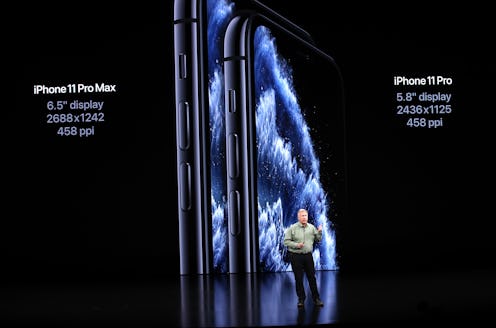Life
Here's How Each Of The New iPhone 11 Screen Sizes Compare With Older Models

When it comes to choosing your next smartphone, there are lots of factors to consider. For some people, screen size is a crucial part of this decision, so comparing displays on different models is important. If you're looking to get a new iPhone with the largest screen size, you have several options — one of which is part of Apple's brand new iPhone 11 series.
The newly-released iPhone 11 Pro Max and 2018's iPhone XS Max are tied for the biggest-ever iPhone screen sizes, with each boasting a 6.5-inch display. According to Apple's technical specifications, both models are also quite similar in terms of overall dimensions. The 2019 Pro Max has a height of 6.22 inches, width of 3.06 inches, and depth of 0.32 inches, while the 2018 XS Max boasts a height of 6.20 inches, width of 3.05 inches, and depth of 0.30 inches.
Both phones feature a super retina XDR display and an all‑screen OLED multi‑touch display, according to Apple, so what you see on your display will be of the highest quality. One physical difference between the two devices (outside of camera differences), however, is their weight. The new iPhone 11 Pro Max weighs in at 7.97 ounces, while the older XS Max model weighs 7.34 ounces, per Apple.
For those looking for a smaller screen, there are also lots of options available. According to the company's technical specifications, Apple's other two newest iPhones, the iPhone 11 and the iPhone 11 Pro, have displays of 6.1 inches and 5.8 inches, respectively. Similarly, Apple's other 2018 models, the iPhone XR and the iPhone XS, also have respective display sizes of 6.1 and 5.8 inches, the company says.
Notably, the iPhone 11 and the iPhone XR both have LCD displays, and like the 11 Pro Max and XS Max models, the 11 Pro and XS models have OLED displays. If you're looking for higher display quality, the models with OLED functionality could be a better fit.
To find additional screen size options, you'll have to go back to the 2017 iPhone models — the iPhone 8, iPhone 8 Plus and the iPhone X. Per Apple's specifications, these models have respective 4.7-inch, 5.5-inch and 5.8-inch displays. As you go back to even older models, display sizes increasingly become smaller, with the smallest-ever iPhone display size being 3.5 inches. This display size was featured on the very first iPhone released in 2007 and on subsequent models all the way through 2011. In 2012, Apple finally came out with its first slightly larger display — the iPhone 5, which had a display size of 4 inches.
As you can see, the iPhone's screen size has gradually increased over the years, with 2018 and 2019 featuring models that are almost double the size of the initial 3.5-inch iPhone. If you're planning to order a new iPhone 11 model — or exploring purchasing an older version of the phone — be sure to take the time to determine which screen size makes most sense for you, because it's something that very much affects your day-to-day use of the phone.
This article was originally published on